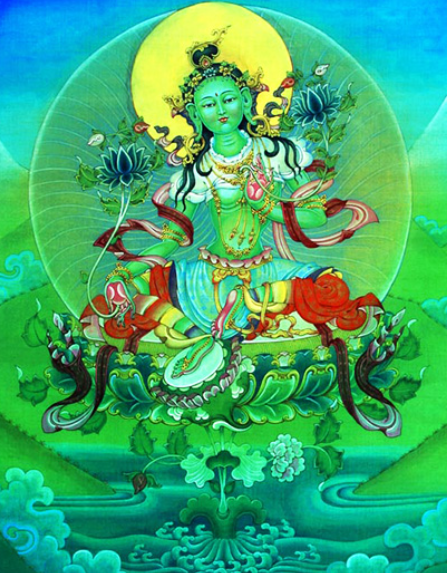The Origin of Green Tara in Buddhist Scriptures: Mother of Compassion and Swift Action
Discover the fascinating origins of Green Tara, the beloved female Buddha of compassion and swift action in Tibetan Buddhism. From her powerful vow as Princess Yeshe Dawa to her emergence from Avalokiteshvara’s tear, this blog explores the sacred stories, symbolism, and spiritual significance behind one of Buddhism’s most revered deities.
7/3/20253 min read


The Origin of Green Tara in Buddhist Scriptures: Mother of Compassion and Swift Action
In the rich and vibrant world of Tibetan Buddhism, few figures inspire as much devotion and reverence as Green Tara, the compassionate savior, the swift protector, and the embodiment of enlightened activity. Recognized as a female Bodhisattva—or more precisely, a female Buddha—Green Tara is not only a symbol of compassion in action but also a spiritual ally for those who seek protection from fear, obstacles, and suffering. Her story, deeply rooted in Buddhist scriptures and mythology, continues to inspire spiritual seekers across centuries and cultures.
Who Is Green Tara?
Green Tara (Sanskrit: Syamatara; Tibetan: Sgrol-ljang) is considered a manifestation of the enlightened mind of compassion, specifically embodying active compassion—swift and fearless in response to suffering. She is often depicted as a beautiful young woman seated in a posture of readiness, her right leg extended slightly, symbolizing her willingness to spring into action to aid those in distress.
Among the 21 forms of Tara, Green Tara is the most universally beloved, representing liberation from fear, hardship, and the cycles of samsara. Her green color symbolizes the dynamic energy of compassion and the vitality of enlightened activity.
The Scriptural Origins of Green Tara
The story of Tara’s origin can be traced back to several important Mahayana and Vajrayana Buddhist texts, particularly in Tibetan Buddhist traditions. While she is not found in early Theravāda texts, Tara emerges prominently in later Mahayana and Tantric scriptures.
1. The Story of Princess Yeshe Dawa
One of the earliest accounts of Tara's origin is found in the Praises to the 21 Taras and other Tibetan canonical texts. According to legend, Tara began as a devoted princess named Yeshe Dawa (“Wisdom Moon”) in a distant aeon. She attained high spiritual realization and was advised by monks to pray for rebirth as a man in order to progress further on the path to enlightenment.
But Yeshe Dawa, recognizing the emptiness of gender in ultimate truth, vowed to always be reborn as a woman until all beings were liberated. Her powerful aspiration and bodhicitta (enlightened mind) led her to attain full Buddhahood, and from that day, she became known as Tara, “The One Who Liberates.”
“There are many who desire enlightenment in a man’s form,
But none who work for the benefit of beings in a woman’s form.
Therefore, until samsara is empty, I shall work for the benefit of beings in a woman’s form.”
— The vow of Tara as recorded in Tibetan scriptures
2. The Tear of Avalokiteshvara
Another popular account of Tara’s origin comes from the Tantric Mahayana tradition, where she is described as arising from the tears of Avalokiteshvara (Chenrezig), the great Bodhisattva of compassion. Moved by the endless suffering of sentient beings, Avalokiteshvara wept, and from his tears, two lotuses bloomed. From one arose Green Tara, embodying enlightened activity, and from the other, White Tara, embodying long life and compassion.
This origin story emphasizes the inseparable nature of compassion and action. Where Avalokiteshvara represents the compassionate intention to help all beings, Tara is the active force that responds instantly to cries for help.
Green Tara in Practice
Devotees of Green Tara engage in visualization meditations, mantra recitation, and ritual offerings to connect with her energy. The most widely chanted mantra is:
"Om Tare Tuttare Ture Soha"
This mantra is believed to remove physical, emotional, and spiritual obstacles, and invite the swift protection and blessings of Tara.
Each part of the mantra has layered meanings:
Om – the universal sound
Tare – liberation from mundane fears
Tuttare – protection from spiritual dangers
Ture – bestows success in spiritual practice
Soha – grounding the prayer in the heart
Symbolism of Green Tara
Every aspect of Green Tara’s iconography reflects her function as the Mother of Liberation:
Green color – Active compassion and vitality
Right leg extended – Readiness to act for the benefit of others
Lotus flowers – Purity and spiritual awakening
Seven eyes – Symbolizing her all-seeing wisdom and compassion
Conclusion: A Timeless Archetype of Compassion
The origin stories of Green Tara—whether as a fearless princess defying gender norms or a tear-born savior from Avalokiteshvara—speak to her timeless relevance. She is a powerful symbol of courageous compassion, of spiritual feminine wisdom, and of the possibility of enlightenment for all beings, regardless of form or status.
For modern practitioners, Green Tara offers not just mystical protection, but also a profound reminder: compassion is not passive—it is swift, responsive, and fearless.
May Green Tara protect and inspire all who walk the path of awakening. 🌿
Community
Explore teachings, prayers, and cultural events.
Address
Sera Jey Wisdom Center
Ruko Savoy Blok C1 No.31 & 32,
River Garden Jakarta Garden City,
Cakung Timur, Jakarta Timur 13910,
Indonesia
+62 813 2488 4241
© 2025. All rights reserved.
